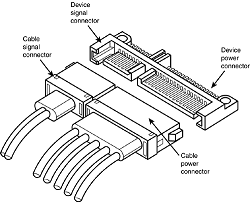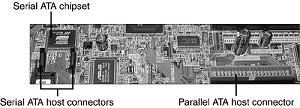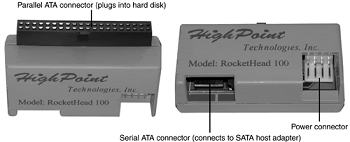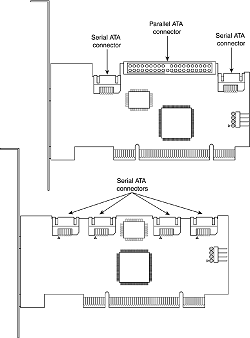Serial ATA
With the introduction of ATA-7, it seems that the Parallel ATA standard that has been in use for more than 10 years is running out of steam. Sending data at rates faster than 133MBps down a parallel ribbon cable is fraught with all kinds of problems because of signal timing, electromagnetic interference (EMI), and other integrity problems.
The solution is in a newer ATA interface called Serial ATA, which is an evolutionary backward-compatible replacement for the Parallel ATA physical storage interface. Serial ATA is backward-compatible in that it is compatible with existing software, which will run on the new architecture without any changes.
In other words, the existing BIOS, operating systems, and utilities that work on Parallel ATA will also work on Serial ATA. This means Serial ATA supports all existing ATA and ATAPI devices, including CD-ROM and CD-RW drives, DVD drives, tape devices, SuperDisk drives, and any other storage devices currently supported by Parallel ATA.
Of course, they do differ physically—that is, you won't be able to plug Parallel ATA drives into Serial ATA host adapters and vice versa. The physical changes are all for the better because Serial ATA uses much thinner cables with only seven pins that are easier to route inside the PC and easier to plug in with smaller redesigned cable connectors.
The interface chip designs also are improved with fewer pins and lower voltages. These improvements are all designed to eliminate the design problems inherent in Parallel ATA.
Although Serial ATA won't immediately replace Parallel ATA, many new systems are now shipping with Serial ATA interfaces alongside Parallel ATA interfaces. Eventually, SATA will replace Parallel ATA as the de facto standard internal storage device interface found in PCs.
As current motherboard designs indicate, the transition from ATA to SATA is a gradual one, and during this transition Parallel ATA capabilities will continue to be available. I would also expect that with more than a 10-year history, Parallel ATA devices will continue to be available even after most PCs have gone to SATA.
Development for Serial ATA started when the Serial ATA Working Group effort was announced at the Intel Developer Forum in February 2000. The initial members of the Serial ATA Working Group included APT Technologies, Dell, IBM, Intel, Maxtor, Quantum, and Seagate.
The first Serial ATA specification 1.0 draft specification was released in November 2000 and officially published as a final specification in August 2001. The Serial ATA II extensions to this specification, which make Serial ATA suitable for network storage, were released in October 2002.
Both can be downloaded from the Serial ATA Working Group. Since forming, the group has added more than 100 Contributor and Adopter companies to the membership from all areas of industry. Systems using Serial ATA were first released in late 2002.
The performance of SATA is impressive, although current hard drive designs can't fully take advantage of its bandwidth. Three variations of the standard are proposed that all use the same cables and connectors; they differ only in transfer rate performance.
Initially, only the first version will be available, but the roadmap to doubling and quadrupling performance from there has been clearly established. Table 1 shows the specifications for the current and future proposed SATA versions; the next-generation 300MBps version is not expected until 2005, whereas the 600MBps version is not expected until 2007.
| Serial ATA Type | Bus Width (Bits) | Bus Speed (MHz) | Data Cycles per Clock | Bandwidth (MBps) |
|---|---|---|---|---|
| SATA-150 | 1 | 1500 | 1 | 150 |
| SATA-300 | 1 | 3000 | 1 | 300 |
| SATA-600 | 1 | 6000 | 1 | 600 |
You can see that Serial ATA sends data only a single bit at a time. The cable used has only seven wires and is a very thin design, with keyed connectors only 14mm (0.55'') wide on each end. This eliminates problems with airflow around the wider Parallel ATA ribbon cables.
Each cable has connectors only at each end, and each cable connects the device directly to the host adapter (typically on the motherboard). There are no master/slave settings because each cable supports only a single device.
The cable ends are interchangeable—the connector on the motherboard is the same as on the device, and both cable ends are identical. Maximum SATA cable length is 1 meter (39.37''), which is considerably longer than the 18'' maximum for Parallel ATA.
Even with this thinner, longer, and less expensive cable, transfer rates initially of 150MBps (nearly 13% greater than Parallel ATA/133) and in the future up to 300MBps and even 600MBps are possible. Serial ATA uses a special encoding scheme called 8B/10B to encode and decode data sent along the cable.
The 8B/10B transmission code originally was developed (and patented) by IBM in the early 1980s for use in high-speed data communications. This encoding scheme is now used by many high-speed data transmission standards, including Gigabit Ethernet, Fibre Channel, FireWire, and others.
The main purpose of the 8B/10B encoding scheme is to guarantee that there are never more than four 0s (or 1s) transmitted consecutively. This is a form of Run Length Limited (RLL) encoding called RLL 0,4 in which the 0 represents the minimum and the 4 represents the maximum number of consecutive 0s in each encoded character.
8B/10B encoding also ensures that there are never more than six or less than four 0s (or 1s) in a single encoded 10-bit character. Because 1s and 0s are sent as voltage changes on a wire, this ensures that the spacing between the voltage transitions sent by the transmitter are fairly balanced, with a more regular and steady stream of pulses.
This presents a more steady load on the circuits, increasing reliability. The conversion from 8-bit data to 10-bit encoded characters for transmission leaves several 10-bit patterns unused. Many of these additional patterns are used to provide flow control, delimit packets of data, perform error checking, or perform other special needs.
The physical transmission scheme for SATA uses what is called differential NRZ (Non-Return to Zero). This uses a balanced pair of wires, each carrying plus or minus 0.25V (one quarter-volt). The signals are sent differentially: If one wire in the pair is carrying +0.25V, the other wire is carrying –0.25V, where the differential voltage between the two wires is always 0.5V (a half-volt).
This means that for a given voltage waveform, the opposite voltage waveform is sent along the adjacent wire. Differential transmission minimizes electromagnetic radiation and makes the signals easier to read on the receiving end.
A 15-pin power cable and power connector is optional with SATA, providing 3.3V power in addition to the 5V and 12V provided via the industry-standard 4-pin device power connectors. Although it has 15 pins, this new power connector design is only 24mm (0.945'').
With 3 pins designated for each of the 3.3V, 5V, and 12V power levels, enough capacity exists for up to 4.5 amps of current at each voltage, which is plenty for even the most power-hungry drives.
For compatibility with existing power supplies, SATA drives can be made with the original, standard 4-pin device power connector or the new 15-pin SATA power connector—or both. If the drive doesn't have the type of connector you need, adapters are available to convert from one type to the other.
Figure below shows what the new SATA signal and power connectors look like.

Figure below shows SATA and Parallel ATA host adapters on a typical motherboard.

Configuration of Serial ATA devices is also much simpler because the master/slave or cable select jumper settings used with Parallel ATA are no longer necessary. BIOS setup for Serial ATA drives is also quite simple.
Because Serial ATA is based on ATA, autodetection of drive settings on systems with Serial ATA connectors is performed in the same way as on Parallel ATA systems. Depending on the system, Serial ATA interfaces might be enabled by default or might need to be enabled in the BIOS setup program.
Because Serial ATA is based on Parallel ATA, you can adapt ATA-100 and ATA-133 hard disks to a Serial ATA host adapter with a converter such as the HighPoint RocketHead 100 device shown in Figure below.

This converter is included with HighPoint Serial ATA RAID host adapters, and similar devices can be purchased from aftermarket vendors.
If you want to use Serial ATA drives but don't want to install a new motherboard with Serial ATA host adapters already included, you can install a separate Serial ATA host adapter into a PCI expansion slot (see Figure below). Most of these adapters include ATA RAID functions.

Some of the first Serial ATA host adapters, such as models from HighPoint and 3Ware, use a Parallel-to-Serial ATA bridge technology that consumes as much as half of the available bandwidth.
Other adapters, such as those made by Promise Technology, use native Serial ATA controller chips, which is a better solution in theory because it preserves all the bandwidth for use by the drive.
However, current Serial ATA drives, like their Parallel ATA siblings, cannot transfer data at anything close to the 150MBps rate of the host adapter; 40MBps–50MBps is the typical range for the first generation of 7200rpm Serial ATA drives, such as the Seagate Barracuda V.
As with Parallel ATA, Serial ATA was designed to be the primary storage interface used inside a PC and was not designed to be used as an external interface.
As such, SATA is not designed to compete with high-speed external device interfaces, such as SCSI, USB 2.0, or IEEE-1394 (FireWire). Therefore, I expect it to replace Parallel ATA in systems over the next few years.